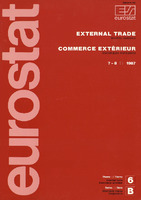| dc.description.abstract | The evolution of the value of trade over time is affected by
changes in prices and exchange rates, and by changes in
quantities transacted. Indices are used to disentangle these
two effects. Usually an index system is chosen so that the
change in the volume index multiplied by that of the price
index gives the value change between two periods. There are
several good systems of index numbers in common use
which have this property. The results from one system will as
a rule be slightly different from those of another. For various
reasons Member States do not use a common index system,
and the degree to which they break down their indices by
product group and partner zone also differs. For these
reasons, Eurostat has constructed its own external trade
indices to obtain Community indices calculated for each
country on a strictly comparable basis.
In principle there are two ways of obtaining price information. One is by means of direct price surveys of importers
and exporters, and the other is to use the value and quantity
data collected by customs. At present only the latter is
available for all countries. Because of this, Eurostat's price
indices are calculated from unit values, customs values
divided by customs quantities. Unit value indices have the
advantage of being cheap to produce, since they use data
collected for other purposes. In addition unit values are
available for most items that are traded, and they refer to
those that are actually passing through customs thus avoiding problems of fictitious prices and time lags. On the other
hand the customs data, especially the quantities, may be
subject to error from rounding, estimation, or the unavailability of the most appropriate units. Moreover unit values can
be calculated only for the product categories distinguished
by customs, and thus mav be the average price of several
distinct products. Whenever the composition varies, be it
randomly in the short run or systematically in the long run,
the result will be that changes in a unit value can occur
which are unrelated to genuine price movements, though in
the former random variation case, one might hope that the
effect of averaging over large numbers of items would
reduce the variability considerably. In order to minimize
these disadvantages, Eurostat has heeded two guiding principles in calculating unit value indices. The first is to use the
most disaggregated data available to it, namely the detailed
harmonized Nimexe data for each Member State's trade with
each of its individual partner countries. The second principle
is to remember that the aim is for a decomposition into price
and volume. Individual unit value changes which move in a
way that would imply an implausible underlying price movement are not used. Two rules are used to exclude implausible price behaviour. The first is that, relative to the general
level of inflation, the price of an item will not differ enormously from its price over the previous full year. Any
changes of a factor of 5 or more are treated as suspect. The
second more restrictive rule is that price changes from the
nearest available month for which there is information will
not differ too much from the median price change tor similar
items. The application of these rules filters out extreme
changes due to non-price factors, which would otherwise
distort the unit value index. Items whose unit values are
rejected or are missing because of no trade in them have
their unit value changes imputed from those of similar
items.
Eurostat calculates annually-chained Fisher 'Ideal' indices.
A Fisher index will normally be lower than a Laspeyres index
but above a Paasche one. The 'basket of goods' traded
internationally changes rapidly over time, so annual chaining
keeps the index weights up-to-date. Each month, the unit
value changes for the finely detailed product categories are
weighted together to give unit value changes for various
broad product categories. These are unit value indices with
the previous year as base year ('index links'). They cover
goods imported into or exported from free circulation. The
corresponding volume index link is derived by dividing the
unit value link into the change in value from the monthly
average of the previous year for relevant products, whether
in free circulation or not. The published monthly indices are
calculated by multiplying the above-mentioned links by the
annual indices for the previous year with reference year
1980. The annual unit value links are found by weighting
together by volume the monthly links, and the annual volume
links are derived by dividing the annual value changes, using
the latest revision of the data, by the annual unit value
links. |

